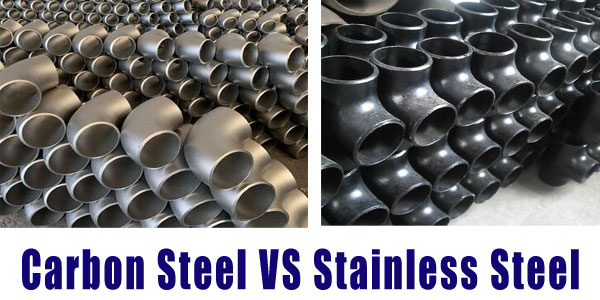Carbon Steel vs Stainless Steel
Steel is the foundation in all kinds of products, from aerospace, automobile to daily life kitchenware. Steel is a term of the description of metal alloys. It has hundreds of application-specific grades. But, most of us understand steel in two main categories: carbon steel vs stainless steel.
In this article, we will discuss the difference between carbon steel and stainless steel. The benefits of carbon steel and stainless steel, The applications, and how to choose it.

Definitions
Stainless steel
As its name, no rust. Actually because of the Chromium element. The most difference between stainless steel and carbon steel is chromium content. Chromium is a key factor. It reacts with oxygen to create a passive layer that protects the steel from corrosion.
Chromium is a metallic alloying element that has a silvery sheen, resists tarnishing, and has a high melting point. What its primary function in steel is corrosion resistance.
Stainless steel is designed to protect against oxidization.
Its feature is the chromium content of 10.5% by mass. This is important because chromium, unlike iron, isn’t susceptible to oxidation. Chromium can be exposed to oxygen without developing rust or corrosion, making it an invaluable element in the creation of stainless steel.
Stainless steel features a protective layer of chromium that creates a barrier between environmental oxygen and the metal’s iron content. That protection allows stainless steel to function in wet environments without rusting. The higher the chromium content, the better the corrosion resistance.
Carbon steel
Carbon steel definition includes alloy steels. It is composed of iron and 0.12 – 2.00 percent carbon. But for high carbon content, usually up to 2.1% of Cits weight.
As per carbon content, Carbon steels can be classified into 3 main types. Low carbon steel.Medium carbon steel.High carbon steel.
If the carbon content has 2% different, there is a huge variance in physical characteristics(especially hardness).
When people talk about carbon steel, they are usually referring to the high carbon steel used in knives and tools. High carbon steels are very hard. It makes them good at resisting abrasion and retaining shape. They can withstand significant force before deforming.
Unfortunately, hard metals are also brittle. When placed under extreme tensile stress, high carbon steels are more likely to crack than bend.
Low carbon steels are more common than high carbon. Because of (1) lower production costs, (2) greater ductility, and (3) ease of use in manufacturing. Low carbon steels tend to deform under stress instead of breaking. And that ductility makes low carbon steels easy to machine and weld.
They are used in automobile body panels, bolts, fixtures, seamless tubes, and steel plates.
Carbon steel’s stronger and more durable than stainless steel. But Carbon steel lacks the corrosion-resistant properties of its stainless steel counterpart. Carbon steel may rust and corrode when exposed to moisture. Even small amounts of moisture, including moisture vapor in the air, can cause carbon steel to rust. Furthermore, carbon steel is less ductile than stainless steel.
Carbon Steel VS Stainless Steel
To common people, it is easy to distinguish between carbon steel and stainless steel. Carbon steel is dull, with a matte finish. Stainless steel is lustrous with various grades, reflective as a mirror. But it also has more character differences.
Here, we list out 5 main differences between carbon steel VS stainless steel:
| Corrosion Resistance | Mechanical Properties |
| Appearance | Price |
Point 1: Corrosion Resistance
The ability to resist corrosion is the most obvious difference between carbon steels and stainless steel. Only via the name, Stainless steel has more corrosion resistance than carbon steel.
Both carbon steel and stainless steels contain iron. It will be oxidized and rust when exposed to the environment.
Because stainless steel contains chromium. It will create a chromium oxide layer on the surface. Then to protect the rest of the material from degradation and corrosion. So it makes stainless steel is more corrosion resistant than carbon steel.
Carbon steel does not have enough chromium to form this chromium oxide layer, allowing oxygen to bond with the iron. It results in iron oxide or rust. If you consider the corrosion resistance factor, stainless steel is the better choice.
It’s important to pay attention to the stainless steel grade when purchasing appliances and other big-ticket items.
Not all steel is equal. Stainless steel with a minimum of 10.5% chromium content is much cheaper and less durable than one with 16%. And the difference will show in maintenance costs and service life.
Point 2: Mechanical Properties
It is difficult to make sweeping statements about the differences
There are many different types and grades between carbon steel and stainless steel. So in mechanical properties, they will also have many differences.
Stainless steel contains more nickel. So it can be more ductile than carbon steel. But, there are very brittle grades of stainless steel as well, such as the martensitic grades.
Due to the alloying elements that many stainless steel grades contain which increase their strength. So Carbon steels with very low amounts of carbon may not match the tensile strengths of some stainless steels.
If there is enough carbon (at least 0.30% by weight) in the carbon steel, it is more heat-treated than austenitic stainless steel.
Point 3: Appearance
If the end application has an appearance requirement, we have to do the surface treatment.
After post-treatment to carbon steel and stainless steel, all surfaces can be shining and bright. But after the polishing process, carbon steel requires a clear coat or paint rather quickly. Otherwise, the carbon steel will begin to tarnish and eventually rust. But stainless steel will not. And it will keep its luster in the scratched area after being scratched.
For carbon steel, it has to paint or repaint. Otherwise, it will be subject to corrosion.
Point 4: Magnetic properties
Carbon steel, ferritic and martensitic stainless steels are magnetic. Austenitic stainless steels are non-magnetic.
But, they will be magnetic when they are cold-worked and hardened to form martensite transformation. We can use heating treatment to restore its Non-magnetic via eliminate the martensite structure and
Point 5: Price
One more important factor is the price difference between carbon steel and stainless steel. Different grades have varying costs. Stainless steels are generally more expensive than carbon steel. This is mainly to the addition of a variety of alloying elements in stainless steel. Such as chromium, nickel, manganese, and others.
These extra elements all add up to an increased cost over carbon steel. Carbon steel is mostly composed of relatively affordable iron and carbon elements.
Based on your application, if you want a cheaper budget for your next project, carbon steel might be the best option.
How to Choose?
Based on the difference analysis, the choice depends on the specifics of the job or project.
If the job is in a corrosive environment, stainless steel may be the best option. If no appearance considers and money budget lower. carbon steel will be better.
In short, carbon steel can more easily be made razor-sharp and is generally stronger. Whereas stainless steel is longer-lasting thanks to its resistance to corrosion and chipping. It’s all about context. Each material has advantages and disadvantages. The key factor is matching the steel to the job requirements.
After reading this article, if you still have confused about Carbon Steel and Stainless Steel. View the below table. It will be a good primer reference.
| HIGH CARBON STEEL | STAINLESS STEEL |
| Vulnerable to rust | Resistant to rust |
| Brittle | Less brittle |
| Wear-resistant | Less wear-resistant |
In our foundry, Carbon Steel casting and Stainless Steel casting are the 2 main products we are supplying. We purchase different grade carbon steel and stainless steel as raw materials. Such as
- Stainless Steel: CF8 (304), CF3 (304L), CK20 (310), CF8M (316), CF3M (316L), A297 Heat Resistant, A351 Corrosion Resistant, 17-4PH, 15-5PH, Duplex, CA15 (410)
- Carbon Steel: 4340, 8620, WCB, WCC, LCB, CA6NM, 1020, 1030, 1040
If you have any inquiries about Carbon Steel casting and Stainless Steel casting, contact us freely.
